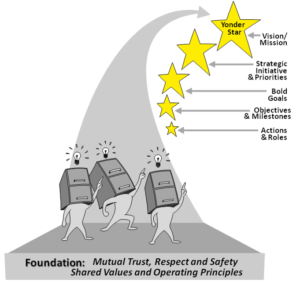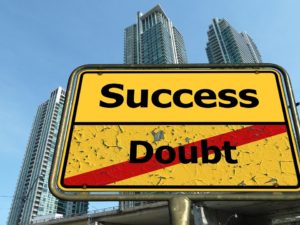By Suzanne Mayo Frindt & Dwight Frindt – Excerpt from Cracking the Business Code
Is your company culture and your leadership practices designed for success in today’s world?

By Brian Hefele
In the face of unrelenting change and increased complexity of issues facing us in business today, our past based practices and structures may not be sufficient to succeed in this new paradigm. Let’s take a look at how company cultures and leadership must shift to respond powerfully to the circumstances we are currently experiencing.
People don’t really fear change itself; they can become afraid that they won’t be successful in the new paradigm. It is the job of leadership to create conditions, a culture, where people can learn, grow, and adapt to be successful in today’s world.
Change and Change Again
Our world is rapidly shaping in many amazing ways:
♦ As the video, Shift Happens has pointed out to the millions of YouTube viewers who have seen it on the Internet, “We are currently preparing students for jobs that don’t exist, who will be using technology we haven’t yet discovered, to solve problems we don’t even yet know about yet” (Shift Happens video, created by Karl Fisch and modified by Scott McLeod).
♦ The quantity of information, its availability, and speed of delivery are increasing at an exponential rate as costs are approaching zero.
♦ The number of people accessing and using this information, and the many ways it is disseminated, has exploded since the advent of personal computers and the Internet — which in turn exponentially speeds up the rate at which new technologies are developed.
♦ Women are stepping into leadership roles at all levels, in diverse venues and in unprecedented numbers all over the world.
♦ Awareness that our global environment cannot continue to withstand a collective human consumption race is spreading quickly.
♦ Our children are being born into and growing up in a world that is so different than the one we grew up in, that it requires a new way of being for them to lead successful lives.
♦ More people over 65 are alive today than have ever lived to that age, so that group will be looking for whole new models for leading healthy, successful lives.
The list of changes that we have already experienced is inexhaustible. And as soon as you read this article, there will be even more changes that have occurred. Accelerated change has become the new normal. At the same time, we hear many clients say “as soon as it slows down or gets back to normal.” Those who think there will be a return to the “good ole days” are in for a great shock.
Our cultures, leadership, and structures have to shift from top down to valuing learning and expanding capacities to problem solve in the face of uncertainty, mining all available wisdom and creativity.
Culture…What’s That?

By rekre89 (Flickr)
Excellent companies have Financial Strategies, Operational Strategies, Marketing and Sales Strategies, and commensurate Resource Allocation Strategies (including People, Time, Money, Equipment/Assets, etc.). How many companies actually have a Cultural Strategy? Yet all companies have a culture, implicitly if not explicitly. They have been developed on a historical basis and impact productivity, success, and health for generations. And, they can be experienced differently depending on one’s position within the organization.
Our first conversations with executives about Culture and Culture Strategies begin with a definition — a shared definition. Since so much of what comprises a culture is often accidental and somewhat invisible, some people have a hard time accepting that there is one, or that it can be defined or even changed.
Once we work through a few of the definitions below, most CEOs and executives agree they do have a definite culture. Then comes the question of whether it is the most productive culture given their purpose, values, and the changes we are experiencing every day.
A company culture can be defined as:
♦ A cognitive framework consisting of attitudes, values, behavioral norms, and expectations. (Greenberg and Baron, 1997)
♦ The collective thoughts, habits, attitudes, feelings, and patterns of behavior. (Clemente and Greenspan, 1999)
♦ The pattern of arrangement, material, or behavior, which has been adopted by a society (corporation, group, or team) as the accepted way of solving problems. (Ahmed et al., 1999)
♦ Includes the organizational values, mission, norms, working language, systems, beliefs, and habits. It is also the pattern of such collective behaviors that are taught to new organizational members as a way of perceiving and even thinking and feeling. (Wikipedia)
♦ A set of shared mental assumptions that guide interpretation and action in organizations by defining appropriate behavior for certain situations. (Ravasi and Shultz 2006)
From this collection of definitions of culture, it becomes clear that a group or an organization’s culture is foundational to the success or failure of all other strategies, and yet little, if any attention, is consciously placed on the care and feeding of a productive culture. It is the invisible glue that binds together ever more diverse workforces, including people from many cultures and generations. Since it is invisible, most executives are not conscious of culture or of the implications of their decisions on the development of, or the degradation of, culture. Organizations in a high growth or acquisition mode are at a high risk of failure due to culture clashes. It is very unusual for us to see organizations that understand the criticality of this dimension of an acquisition, or adding lots of employees in a short period of time. Without a clear and intentional culture strategy, along with the allocation of resources to be sure that it is communicated and very well understood and incorporated into every day business interactions, the culture is drastically impacted by whatever the acquisition brought with them, or what the large numbers of employees bring with them. The sad reality is that productive organizational cultures often suffer a demise due to an unconscious neglect by leadership.
What people often complain about is usually a description of the unproductive aspects of the culture, at least from their perspective. We have heard from executives: lack of accountability, defensiveness, competitiveness at the expense of the company, or customer outcomes. In an organizational 360 tool that we use, we have heard from the workforce: micro management, lack of trust, no clear direction, compensation, and reward systems that emphasize individual results rather than company success. This was all within the same company!
Many organizations that we have encountered through our leadership development firm, 2130 Partners, have had what we call “accidental” cultures. Perhaps it was generated initially by a founder entrepreneur, mirrors other cultures in the same industry, or was created by a particular hiring practice or compensation structure. Nonetheless, most cultures develop by accident.
Cultures can be designed on purpose, and existing productive cultures can be maintained and enhanced intentionally.
Leadership — Replacing Commands with Vision
In this evolving new reality, successful leadership will have a very different nature than traditional approaches.

By Aadi Sing
It was quite different to be a leader in simpler economic times and when the world moved at a slower pace with less connectivity. There were successful models and practices in place as well as more easily identifiable and attainable goals. Patterns of entitlement offered at least the illusion of security, and there was more time and predictability in producing results. However, now — when previous business models and assumptions have been turned on their heads, when people’s livelihoods are changing and disappearing regularly, and when successful businesses are being transformed for the new realities — the leadership required is radically agile, proactive, and creative.
Leaders who will be effective in this time of incredible opportunity are those that lead as if they are in a dance with reality — that is, they look to create exciting new paradigms, processes, and even companies based on creating the next game while being responsible for the current and unfolding global economy. They are not simply waiting until the economy gets back to normal or using past experiences to map out current pathways. Being in a dance demands conversations appropriate to dancing. Think about it — when you get out on the dance floor, do you tell your partner, “I need these four steps from you in the next minute, followed by a repetitive pattern until I tell you otherwise”? If you have done that, perhaps you have found that it leaves you with very few dance partners. How then do you engage with others in this new reality?
We call the management model we use to replace the old “command-and-control” paradigm, Vision-Focused Leadership, which is an approach grounded in shared vision and built through collaboration.
Vision: A mental image produced by the imagination
Vision-Focused Leadership as a mental model shows how thinking, listening, speaking, and actions — most importantly those that you employ to lead others — are focused and informed by a shared vision. Focusing on your shared vision allows you to make choices; orient your creativity, energy, and resources; and correlate your thoughts and actions and the actions of people working with you on your shared intention. In the absence of shared vision, it is easy to become victims of or be distracted by circumstances, worries, and fears, and to react based on instant, automatic, unconscious, and unexamined thoughts, beliefs, and judgments stored in your mind. Without necessarily realizing it, the past winds up driving your bus.
When we talk about leadership here, our intention is to stress that leader- ship can be evoked anywhere in an organization — that is, every person can exhibit leadership qualities, no matter what his or her job description may be.
If you and your team members have done a good job developing and sharing the vision, then creating powerful actions will flow much more naturally. People will be able to individually source their ideas, actions, and interactions from the shared vision. If you replace commands with shared vision and broaden the source and responsibility for creativity to the entire team, you will maximize creativity, ownership, collaboration, and velocity in fulfilling the shared vision.
We use the term “Yonder Star” to include shared vision, goals, objectives, and strategies to obtain it. It can be applied at any level from a strategic corporate vision to your vision for the outcomes you intend to produce in a single conversation or meeting. The Yonder Star is the ideal, out in front of you and up above the path you are currently traveling, that provides a common focus and inspires your actions. Rather than hanging onto sacred past-based activities and processes (i.e., “what did we do and how did we do it last year?”), priorities, plans, and milestones are designed from a focus on the Yonder Star. From this mind-set, actions are prioritized by their value in fulfilling the Yonder Star. All members of the team are inspired to explore their own integration of the goal with their passion to contribute and the specific role their work will play in its fulfillment.
From shared dedication to the overall outcome, a pervasive attitude of “I’ve got your back” naturally develops within each member of the team. Dissent, one-upmanship, and agendas fueled by self-interest tend to fade to the background.
Collaboration Requires
Connection, Alignment, and Focus
 This graphic is our shorthand illustration of this notion. Here we show a group of people who are interacting from a solid foundation of mutual trust, respect, and safety to reach their mutual Yonder Star. In this case, a collection of aligned Yonder Stars, shown in a stack of different sizes, depicts the many intermediate goals that lie between your current situation and fulfillment of your Yonder Star. To sort out which actions will be most productive on your route to your Yonder Star, look back from your fulfilled Yonder Star and ask, “What’s missing in our current reality that, if we work on it, will accelerate fulfilling our Yonder Star?” From your list, determine the decisions and actions that will be most leveraged in closing the gap. By leveraged, we mean the actions that produce the greatest impact while requiring the fewest resources and taking the least amount of time to accomplish. Get started, monitor results, recalibrate with new position updates, and continue on your path or make adjustments as necessary to stay on course.
This graphic is our shorthand illustration of this notion. Here we show a group of people who are interacting from a solid foundation of mutual trust, respect, and safety to reach their mutual Yonder Star. In this case, a collection of aligned Yonder Stars, shown in a stack of different sizes, depicts the many intermediate goals that lie between your current situation and fulfillment of your Yonder Star. To sort out which actions will be most productive on your route to your Yonder Star, look back from your fulfilled Yonder Star and ask, “What’s missing in our current reality that, if we work on it, will accelerate fulfilling our Yonder Star?” From your list, determine the decisions and actions that will be most leveraged in closing the gap. By leveraged, we mean the actions that produce the greatest impact while requiring the fewest resources and taking the least amount of time to accomplish. Get started, monitor results, recalibrate with new position updates, and continue on your path or make adjustments as necessary to stay on course.
Collaboration — New Ways of Working Together
As we go forward, those who lead will be the ones taking advantage of the creativity and productivity gains available by focusing on the human, collaborative dimension, while laggards will suffer in the face of unrelenting change.
The extremely affordable, and nearly instant, access to vast amounts of information and ways of interacting with whole communities that are becoming available, combined with a productive attitude toward change and the new realities it brings, creates huge opportunities for you and your leadership. However, leading effectively will require a new mind-set to unleash potential and creativity and to capitalize on opportunities.
The challenges lie in strengthening your ability to choose the direction, form the goals, and then communicate and enroll others so that you build groups and organizations that can collectively navigate shifting realities. This means improving your ability to communicate, work together collaboratively, and lead others to do so as well. If you learn how to identify and utilize the navigational guides to traversing this uncharted territory, you will experience higher productivity, more rapid innovation, and greater organizational agility. Additionally, responsiveness to the needs of customers and other stakeholders in the organization and more rewarding relationships will become something you can rely upon.
Building Collaborative Capital — It Begins with Me
To effectively change our outer reality requires being willing to shift our inner reality.
Today, talented, educated people who know how and are motivated to work interactively with each other are the key to success for more and more businesses. This new collaborative approach means many more minds are put to work on the opportunities and challenges facing us whether in business, in our organizations, or even in our families.
When we were born, we came equipped with the most powerful computers on earth (although Shift Happens cites projections that the quantitative computing power of a supercomputer will pass that of the human brain by the year 2013). These innate computers serve us well in producing new ideas and dynamic solutions — as we can see in all that has happened just in the past twenty years of technological growth. The core thought processes that guide our reactions and interactions were mostly loaded into your brain and ours when we were children and have been chugging along ever since, functioning as an unconscious and unexamined operating system.
Don’t change the world, change worlds…starting with your own.
Adapted from St. Francis of Assisi, Catholic patron saint of animals and the environment
Being able to think in new ways requires challenging the very basis of your own thinking — your self-concept, worldview, and automatic ways of interacting with others.
What Is a Productive Culture Anyway?

By Anne Davis (773 Flickr)
We don’t use terminology such as “good” or “bad” cultures, which is a binary and simplistic assessment. We consider the organization’s purpose, or vision and mission to determine if the existing culture supports the achievement of that purpose while calling forth the best from the people within the organization. Does it call forth high performance and productivity on a sustainable basis? Does it reward Self-Generated Accountability and Productive Dialogue? Does it foment gossip, jealousy, politics, CYA, or individual success over company success?
What is productive in a culture is what people are proud of about their company or their work. When shared values are demonstrated and memorialized in great stories, people tell about “the time when…”
What If You Created a Learning Culture?
A Learning Culture is one where the individuals and teams consciously invest in growing and developing themselves. In a Learning Culture, executives are conscious and purposeful about the impact of decisions and strategies on the fabric of cultural development. There is a purposeful focus on reducing friction and waste in communications and developing productive working relationships. People know there is an expectation for growing and learning. Hiring decisions are made with an interest in an individual’s ability to learn, adapt, grow, and shift outdated mental models, as much as their past-based, functional experience. An atmosphere of curiosity, forward thinking and ‘how can we learn from this’ thinking permeates. It becomes the foundation or platform on which everything else is built.
What Are The Payoffs of a Learning Culture?
For an organization, this type of culture provides much more innovation, creativity, flexibility, agility, and expedited problem solving capabilities. It also affects retention and even hiring decisions of individuals in the firm.
For individuals, it provides opportunities for learning and growth; enhancing marketability and value to this or other organizations. It also provides forums to be challenged, to add value, and to contribute at a high level. Some CEOs have actually expressed concern that growing their people will make them more vulnerable to their best people leaving. However, if looked at from the individual’s perspective, why would they leave unless they have fully used up the growth opportunities where they are right now? Why would someone leave a position where their value and contribution are recognized, supported, and rewarded?
How Can We Develop a Learning Culture?
There are many books and articles about learning organizations including work by Senge and Argyris that explain in depth about the what and how of learning organizations. Our 2130 methodology (and terminology adaptation in some instances) ties to the 5 aspects of a learning organization that are generally accepted by leadership “gurus” as follows:
1. Systems Thinking: Understanding how things influence each other as a whole. Our view is that executives and organizational leadership are accountable to the entire organization and all stakeholders for this larger view. This includes strategy development, planning, implementation, review, and adjustment. This is a level above what most executives contribute on a day-to-day basis from their functional expertise (Finance, Operations, Sales, Marketing, HR, etc.). In addition to a responsibility for systems thinking on an individual executive basis, it is also critical that the entire executive team itself operate as a productive, learning system. Most organizations develop a Vision statement, Mission, and Values that constitute the overall framework, (we call it the ‘Yonder Star’), and then on a regular basis develop strategies, initiative, goals, and actions in the dimensions of finance, operations, marketing, sales, resource allocation, and to a lesser degree, culture. Our methodology, “Vision-Focused Leadership” is designed to support systems thinking. We work with top executives — the CEO, President, or entrepreneur — in a trusted advisor or executive coaching assignment to create a learning culture. We also work with the team of top executives to support the development of and focus on all the strategies required to be successful. Our Operating Principles create a platform for a productive, learning culture with the executive leadership team and then the entire organization.

By Gerd Altmann
2. Shared Vision/Values: “A vehicle for building shared meaning” from Peter Senge’s Fifth Discipline. Unfortunately, this often looks more like the version from Dilbert: “A long meaningless statement that proves management’s inability to focus.” Over the last 20+ years we have worked with organizations to develop Vision, Mission, and Values using our “Vision-Focused Leadership” methodology. Leadership gurus have been espousing for at least two decades the value of a shared vision to focus and align resources. Absent a shared vision, individual agendas rule the day and gaining personal power becomes a major executive focus. Shared Vision/Values encourage a learning culture by emphasizing the gaps toward our Shared Vision/Values, what is missing and what is next, versus what is wrong from the past.
3. Productive Mental Framework: We talk about busting mental barriers, increasing mental agility, and increasing capacities to deal with the unrelenting pace of change and increased complexity of issues facing leadership today. It requires skills at reframing for ourselves and others, and developing focus in chaos and high emotional states. Past-based arrogance and rigidity undermine productive cultures. It is critical to become aware of our blind spots and biases to be able to think clearly in the present to make the best decisions in a complex business environment. We use our Operating Principles and Essential Notions, developed and validated over the past 20 years to help build a learning culture platform and equip leaders and man- agers with the mental and collaborative skills needed in today’s world.
4. Personal Mastery: This is the commitment of every person in the organization to improve, develop, and challenge themselves to be more than they are today, and to proactively challenge themselves inside a framework of contribution and collaboration. Individuals who insist on status quo and structural barriers to communication usually self-select out of a Learning Culture. In our book, Accelerate: High Leverage Leadership for Today’s World, we say that when individuals develop themselves they have increased their collaborative capacities. We will get older automatically, however to grow as we age requires a conscious choice. In our work, we describe conscious choice as the Leadership Choice Point. Every moment of every day presents an opportunity for choice. Will I relate to the world around me, the circumstances of my life as the defining parameters, or will I choose to use the circumstances as an opportunity to grow toward the Yonder Star?
5. Team Mastery: In addition to individual learning and development, organizations must realize that groups of people, (of any size of two or more), creates yet another “entity” with its own dynamics and productivity levels. Two or more people, who may be very developed individually, when put together in a group or team may not be as productive together as the sum of their individual productivity. The question becomes: will we synergize our efforts where 1+1=3 or more, or will we diminish productivity potential with friction and waste to make 1+1=1.5 or less? There are numerous examples of sports teams that have all “star” players, yet a team of “average” players can beat them because of the way the average players have developed their team effectiveness. The sum of what the players produce together is much greater than adding up individual skills — and so it is for organizational groups and teams. There are group skills and developmental opportunities that build on, yet are distinct from individual capacities. When groups develop these capacities we call that increasing their collaborative capital.
So What Will You Do Now?
1. Take stock of your culture. What are the stories being told about your organization by employees, clients, and vendors? What stories would you like to be told? What attributes of this powerful, invisible platform are important to you? Where are the gaps? What will you commit to taking on, challenging the status quo, and BEING as an example of the cultural aspect you are committed to developing? (We use an online organizational assessment to gather objective and confidential data to understand the present condition in an organization).

By Skeeze (Pixabay)
2. What cultural “artifacts” do you have in place? (We call the collection of these items, all on one page, your Strategic Focus.)
a) Compelling Vision, Mission, and Shared Values (We also use our Operating Principles as a key piece of culture definition because they are design principles for productive conversations.)
b) Business strategy that fulfills the Vision and Mission
c) Bold Goals that clearly take ground toward the strategy and mission, and are consistent with your vision and values
3. Is your Leadership and management team aligned behind #2 above?
4. Has your Strategic Focus been clearly communicated? Does your team know how to communicate it to their folks?
5. Are your departmental and individual goals lined up with the Mission, Vision, and Strategy?
If you are missing any of the above, fill in the missing pieces immediately! If your Vision or Mission statements are a paragraph long or no one remembers them anymore, throw them out! Vision and Mission statements have a positive influence on culture only when they really “live” inside the hearts and minds of people in the organization. It is not a job for the marketing department or your PR firm to “word smith.” It is the role of leadership to capture and communicate and nurture the Vision and Mission and Values. Each executive and management team member must be willing to have their leadership and management practices be guided by these major cultural influencers you create. When the actions or practices of people in management positions are contrary to what have been espoused as values and the mission then there is a huge disconnect for individuals in the organization, resulting in cynicism and resignation.
If you need help, consider hiring a professional facilitator to work with you and your leadership team to help define the existing reality, clearly define each aspect of your Strategic Focus and identify the gaps. Accomplish this first, before working with the balance of your organization, to develop thinking and behaviors consistent with a learning culture and self-generated accountability.
Above all, keep growing and learning and Accelerate your Leadership.
If Leadership is not consciously strategizing, designing, and developing culture, what is left to form it? Culture exists and is alive in the stories employees, (and vendors and customers), tell about what it is like to work there, how people get treated, how to get ahead, whom to hold your tongue around, whom to please, whether merit or seniority count to a greater extent, what happens if you are ill, what are the opportunities for development, promotion, raises, learning. What stories are being told about your company? What stories would you like to be hearing? How does leadership affect those stories? What are the payoffs? These are the questions to ask to get conscious about the affect of your culture.

by Devanath (pixabay)
References:
Accelerate: High Leverage Leadership for Today’s World by Suzanne and Dwight Frindt – to order go to www.2130partners.com.
“Developing a Corporate Culture as a Competitive Advantage” by Golnaz Sadri and Brian Lees .
Peter Michael Senge is an American scientist and director of the Center for Organizational Learning at the MIT Sloan School of Management. He is known as author of the book The Fifth Discipline: The Art and Practice of the Learning Organization (originally 1990, new edition 2006).
Chris Argyris is an American business theorist, Professor Emeritus at Harvard Business School, and a thought leader at Monitor Group. He is commonly known for seminal work in the area of “Learning Organizations.”
Suzanne Frindt is a co-founder and principal of 2130 Partners, an executive leadership development and education firm that launched in 1990. She is also a recognized speaker on the topics of Vision-Focused Leadership™ and Productive Interactions™, speaking to organizations around the world. She is also a Group Chair for Vistage International, Inc. an organization of CEOs and key executives dedicated to increasing the effectiveness and enhancing the lives of more than 12,000 members. Each month she facilitates groups in Orange County, California, and Seattle, Washington, while also regularly contributing entrepreneurial creativity and management experience to several companies through service on their advisory boards.
Dwight Frindt is also a co-founder and principal of 2130 Partners. Since 1994, Dwight has been a Group Chair for Vistage International facilitating groups of CEOs and senior executives. He has received many performance awards for his work at Vistage and in 2009 Dwight became a Best Practice Chair and began mentoring the Chairs in the South Orange County area. Since then he has added two additional Best Practice Chair regions; the Puget Sound and the Greater Pacific Northwest. In 2011 Dwight received the Best Practice Chair of the Year Award – Western Division. Combining his work with 2130 Partners and Vistage, Dwight has facilitated more than 1,000 days of workshops and meetings, and has logged well over 13,000 hours of executive leadership coaching. In addition to working in the for-profit world, Dwight and Suzanne are very committed to working with non-profits and have been investors and activists with The Hunger Project for many years. To reach them, please visit www.2130partners.com.
Permission is needed from Lighthouse Consulting Services, LLC to reproduce any portion provided in this article. © 2016 This information contained in this article is not meant to be a substitute for professional counseling.
If you would like additional information on this topic or others, please contact your Human Resources department or Lighthouse Consulting Services LLC, 3130 Wilshire Blvd., Suite 550, Santa Monica, CA 90403, (310) 453-6556, dana@lighthouseconsulting.com & our website: www.lighthouseconsulting.com.
Lighthouse Consulting Services, LLC provides a variety of services, including in-depth work style assessments for new hires & staff development, team building, interpersonal & communication training, career guidance & transition, conflict management, 360s, workshops, and executive & employee coaching. Other areas of expertise: Executive on boarding for success, leadership training for the 21st century, exploring global options for expanding your business, sales and customer service training and operational productivity improvement. To order the books, “Cracking the Personality Code” and “Cracking the Business Code” please go to www.lighthouseconsulting.com.
We recently launched a new service called Sino-Am Leadership to help executives excel when stationed outside their home country. American managers in Asia and Asian managers in America face considerable business, personal, and leadership challenges because of the cultural differences. This unique program provides personal, one-on-one coaching. For more information visit, https://lighthouseconsulting.com/performance-management/talent-development/sino-american-management-style/.
 “Your prospects are talking, but are you really listening?” asks Stiehl, a human-factors-engineer by training who has worked for the Cadillac division of General Motors, Cisco System, Pacific Gas & Electric, Cisco Systems, and even the Nuclear Regulatory Commission.
“Your prospects are talking, but are you really listening?” asks Stiehl, a human-factors-engineer by training who has worked for the Cadillac division of General Motors, Cisco System, Pacific Gas & Electric, Cisco Systems, and even the Nuclear Regulatory Commission.
 Identify the issue. What is on their mind? What is their goal, what assets do they have in place, and what are their roadblocks? Ask questions to find out and listen carefully.
Identify the issue. What is on their mind? What is their goal, what assets do they have in place, and what are their roadblocks? Ask questions to find out and listen carefully.
 Lighthouse Consulting Services LLC offers custom market research specializing in understanding customer wants, needs and requirements. We have designed and implemented one-on-one in-depth research studies, surveys and quantitative studies across a similar range of internal (employees) and external (customers) audiences. And sometimes we even conduct focus groups.
Lighthouse Consulting Services LLC offers custom market research specializing in understanding customer wants, needs and requirements. We have designed and implemented one-on-one in-depth research studies, surveys and quantitative studies across a similar range of internal (employees) and external (customers) audiences. And sometimes we even conduct focus groups.

 “Know how stressful or intimidating panel interviews can be,” says Crabtree. “Make it fun and interactive. The attitude should be: ‘Let’s have a conversation and get to know each other. Let’s see how this dynamic will work and if you have the skills to do the job successfully.’”
“Know how stressful or intimidating panel interviews can be,” says Crabtree. “Make it fun and interactive. The attitude should be: ‘Let’s have a conversation and get to know each other. Let’s see how this dynamic will work and if you have the skills to do the job successfully.’”
 Lighthouse can help guide your organization in designing and implementing a remote work force platform with the help of our practice specialist through our full service business consulting division For more information please contact
Lighthouse can help guide your organization in designing and implementing a remote work force platform with the help of our practice specialist through our full service business consulting division For more information please contact  Allowing employees to work from remote locations means a company can expand its talent pool from beyond its local geography. According to university/industry research viewed by Lighthouse Consulting Services, LLC, if the right person is selected his or her work production has the potential to increase by 30% to 300%. Obviously, hiring better workers that work remotely can result in increased productivity and client satisfaction.
Allowing employees to work from remote locations means a company can expand its talent pool from beyond its local geography. According to university/industry research viewed by Lighthouse Consulting Services, LLC, if the right person is selected his or her work production has the potential to increase by 30% to 300%. Obviously, hiring better workers that work remotely can result in increased productivity and client satisfaction. One company required that all meetings be done via video conferencing including 1-to-1 meetings. Some staff members may be resistant to being on the camera though making this mandatory to participating in the remote worker program can help emphasize the importance of this connection. Reminding the employee that you see more of them in person than when they are on camera may help ease any anxiety.
One company required that all meetings be done via video conferencing including 1-to-1 meetings. Some staff members may be resistant to being on the camera though making this mandatory to participating in the remote worker program can help emphasize the importance of this connection. Reminding the employee that you see more of them in person than when they are on camera may help ease any anxiety.



 However, the clock is ticking. Our panelists from our monthly Open Line web conference believe it will likely be pre-staged by a series of financial events that trigger a severe pull-back in the market and a rapid slowdown of the economy.
However, the clock is ticking. Our panelists from our monthly Open Line web conference believe it will likely be pre-staged by a series of financial events that trigger a severe pull-back in the market and a rapid slowdown of the economy.
 Dana Borowka, MA, CEO of Lighthouse Consulting Services, LLC and his organization constantly remain focused on their mission statement – “To bring effective insight to your organization”. They do this through the use of in-depth work style assessments to raise the hiring bar so companies select the right people to reduce hiring and management errors. LCS can test in 19 different languages, provide domestic and international interpersonal coaching and offer a variety of workshops – team building, interpersonal communication and stress management. Dana has over 25 years of business consulting experience and is a nationally renowned speaker, radio and TV personality on many topics. He is the co-author of the books, “Cracking the Personality Code”, “Cracking the Business Code” and “Cracking the High-Performance Team Code”. To order the books, please visit
Dana Borowka, MA, CEO of Lighthouse Consulting Services, LLC and his organization constantly remain focused on their mission statement – “To bring effective insight to your organization”. They do this through the use of in-depth work style assessments to raise the hiring bar so companies select the right people to reduce hiring and management errors. LCS can test in 19 different languages, provide domestic and international interpersonal coaching and offer a variety of workshops – team building, interpersonal communication and stress management. Dana has over 25 years of business consulting experience and is a nationally renowned speaker, radio and TV personality on many topics. He is the co-author of the books, “Cracking the Personality Code”, “Cracking the Business Code” and “Cracking the High-Performance Team Code”. To order the books, please visit 
 Exit interviews are specifically designed for the employer. They do not help the exiting employee at all, because the exiting employee usually needs a reference from the company they are leaving. Telling the truth about the company doesn’t help the employee get that reference, and in certain circumstances, the information gleaned from the interview could be used against them. In addition, if there is negative feedback given, it is sometimes dismissed by the interviewer. “Well, that employee is just mad, so their feedback isn’t accurate.” My belief is that if an employee is leaving the company, they have attempted to tell someone in the company why. Whether it is a review, a conversation or a complaint, most employees don’t just up and leave without some sort of a notification.
Exit interviews are specifically designed for the employer. They do not help the exiting employee at all, because the exiting employee usually needs a reference from the company they are leaving. Telling the truth about the company doesn’t help the employee get that reference, and in certain circumstances, the information gleaned from the interview could be used against them. In addition, if there is negative feedback given, it is sometimes dismissed by the interviewer. “Well, that employee is just mad, so their feedback isn’t accurate.” My belief is that if an employee is leaving the company, they have attempted to tell someone in the company why. Whether it is a review, a conversation or a complaint, most employees don’t just up and leave without some sort of a notification.
 2. You set a great example for the entire organization that the leadership cares. The word will get out that the losing organization leaders cared enough to at least ask. If there is a standard practice of exit interviews and things changed in the organization for the better as a result of what was learned, there can be great benefit to the organization.
2. You set a great example for the entire organization that the leadership cares. The word will get out that the losing organization leaders cared enough to at least ask. If there is a standard practice of exit interviews and things changed in the organization for the better as a result of what was learned, there can be great benefit to the organization.
















